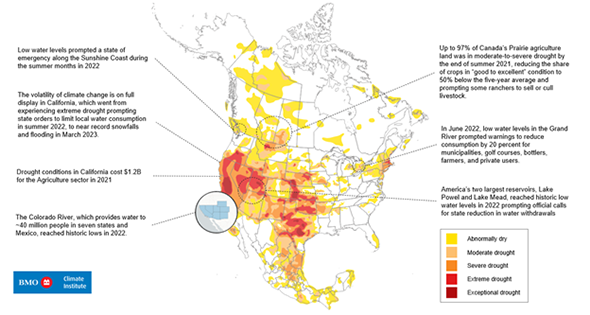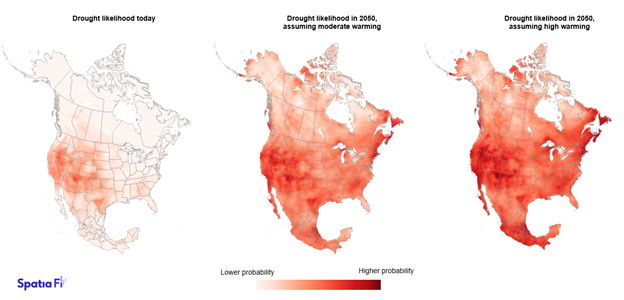
Water Scarcity: Closer to Home Than You Might Think
-
bookmark
-
print
Predictable, consistent water availability is foundational to resilient businesses and supply chains.
Having more freshwater reserves than almost anywhere in the world, many in the United States and Canada might feel like drought and water scarcity are something that happens to other people in other places.
In fact, this challenge is closer to home than many of us might think.
Despite boasting an overall surplus, freshwater resources are not evenly distributed across our population. As a result, water stress is common across western North America, including in the Canadian prairies and the interior of British Columbia.
The US Southwest is particularly hard-hit, and has been in a “megadrought” since early 2000, marking its driest 22-year period in approximately 1200 years and compounding socio-economic consequences across industries and value chains (Figure 1).

FIGURE 1: Recent drought conditions and associated impacts experienced across North America. Sources: National Drought Mitigation Center at the University of Nebraska-Lincoln, the United States Department of Agriculture, and the National Oceanic and Atmospheric Administration; NASA; US Department of Interior; Government of California; Statistics Canada; Agriculture Canada, and Emergency Info BC.
While water shortages and drought are often regionally localized, persistent water scarcity can impact international supply chains and can drive up the cost of goods for end consumers.
As temperatures rise globally, drought patterns are exacerbated by the shifting balance between water inputs and outputs; patterns and timing of precipitation are shifting as the climate warms while, at the same time, warmer air temperatures are evaporating more water from reservoirs, lakes, and soils. As a result, the challenges faced by water-stressed regions are expected to grow in the decades to come as a warmer climate could cause drought events to become likely (Figure 2). What’s more, areas that currently experience infrequent drought conditions could begin experiencing these conditions more often. For businesses, this means you can’t assume that the water needed to run your operation today will be as available in the future, so they need to plan accordingly.

FIGURE 2: Likelihood of drought conditions being experienced across North America today and in 2050 under multiple future warming scenarios. Source: SpatiaFi.
As well as these evolving environmental pressures, are considerations like population growth, municipal water consumption, economic activities that consume and/or divert water from natural systems, and growing demand for power generation, all of which rely on predictable patterns in water availability.
Water scarcity is also very often a transboundary issue, requiring coordination between multiple stakeholders. Such complex interactions highlight the need for evolving water management strategies and consumption patterns in the face of shifting patterns of availability in a warming climate.
Holding more than 20% of the world’s freshwater reserves, North America boasts rich and diverse freshwater resources, but it is also home to some of the highest per-capita water consumption globally. Businesses and supply chains rely on effective management of this shared resource, which means that every drop will matter as we plan for a sustainable future.
Read more about how businesses can do their part to manage their water use and plan for the future.
The BMO Climate Institute, in partnership with Climate Engine and their SpatiaFi product, are advancing unique spatial finance capabilities to quantify the location-specific impact of climate change. We are identifying impacts across a wide variety of hazards including flooding, drought, extreme heat, wildfire, and more, today and into the future, to understand the evolving nature of how climate change is expected to occur and what this means for operational resilience. With this information we are informing financing strategies, guiding client engagement, and managing climate impacts for clients and the bank.

Water Scarcity: Closer to Home Than You Might Think
Senior Manager, Climate and Sustainability Strategy
George leads initiatives to identify key sustainability issues and advance programs relating to BMO’s sustainability and climate performance. He works cross-f…
George leads initiatives to identify key sustainability issues and advance programs relating to BMO’s sustainability and climate performance. He works cross-f…
VIEW FULL PROFILE-
Minute Read
-
Listen
Stop
-
Text Bigger | Text Smaller
Predictable, consistent water availability is foundational to resilient businesses and supply chains.
Having more freshwater reserves than almost anywhere in the world, many in the United States and Canada might feel like drought and water scarcity are something that happens to other people in other places.
In fact, this challenge is closer to home than many of us might think.
Despite boasting an overall surplus, freshwater resources are not evenly distributed across our population. As a result, water stress is common across western North America, including in the Canadian prairies and the interior of British Columbia.
The US Southwest is particularly hard-hit, and has been in a “megadrought” since early 2000, marking its driest 22-year period in approximately 1200 years and compounding socio-economic consequences across industries and value chains (Figure 1).

FIGURE 1: Recent drought conditions and associated impacts experienced across North America. Sources: National Drought Mitigation Center at the University of Nebraska-Lincoln, the United States Department of Agriculture, and the National Oceanic and Atmospheric Administration; NASA; US Department of Interior; Government of California; Statistics Canada; Agriculture Canada, and Emergency Info BC.
While water shortages and drought are often regionally localized, persistent water scarcity can impact international supply chains and can drive up the cost of goods for end consumers.
As temperatures rise globally, drought patterns are exacerbated by the shifting balance between water inputs and outputs; patterns and timing of precipitation are shifting as the climate warms while, at the same time, warmer air temperatures are evaporating more water from reservoirs, lakes, and soils. As a result, the challenges faced by water-stressed regions are expected to grow in the decades to come as a warmer climate could cause drought events to become likely (Figure 2). What’s more, areas that currently experience infrequent drought conditions could begin experiencing these conditions more often. For businesses, this means you can’t assume that the water needed to run your operation today will be as available in the future, so they need to plan accordingly.

FIGURE 2: Likelihood of drought conditions being experienced across North America today and in 2050 under multiple future warming scenarios. Source: SpatiaFi.
As well as these evolving environmental pressures, are considerations like population growth, municipal water consumption, economic activities that consume and/or divert water from natural systems, and growing demand for power generation, all of which rely on predictable patterns in water availability.
Water scarcity is also very often a transboundary issue, requiring coordination between multiple stakeholders. Such complex interactions highlight the need for evolving water management strategies and consumption patterns in the face of shifting patterns of availability in a warming climate.
Holding more than 20% of the world’s freshwater reserves, North America boasts rich and diverse freshwater resources, but it is also home to some of the highest per-capita water consumption globally. Businesses and supply chains rely on effective management of this shared resource, which means that every drop will matter as we plan for a sustainable future.
Read more about how businesses can do their part to manage their water use and plan for the future.
The BMO Climate Institute, in partnership with Climate Engine and their SpatiaFi product, are advancing unique spatial finance capabilities to quantify the location-specific impact of climate change. We are identifying impacts across a wide variety of hazards including flooding, drought, extreme heat, wildfire, and more, today and into the future, to understand the evolving nature of how climate change is expected to occur and what this means for operational resilience. With this information we are informing financing strategies, guiding client engagement, and managing climate impacts for clients and the bank.
You might also be interested in
A Buyer’s Guide to Corporate Offsetting and Navigating the Voluntary Carbon Market
Why Sustainability Is Good Business: Key Takeaways from IEFA Toronto 2024

Building for Tomorrow: Real Estate, Construction, and Sustainability
A First in Western Canada: Avenue Living Leverages BMO's Retrofit Program to Add 179 New Rental Units in Downtown Edmonton

How NASA and IBM Are Using Geospatial Data and AI to Analyze Climate Risks
BMO Arranges Green Financing to Fund New Lawson Centre for Sustainability, Trinity College's Most Significant Build in a Century
BMO ranked one of the most sustainable companies in North America on the Dow Jones Sustainability Indices
Canada Has an Opportunity to Become a Global Leader in Carbon Dioxide Removal
BMO Climate Institute Business Leaders Survey: Nearly Half of Business Leaders in the U.S. and Canada Believe Climate Change Has Already Affected Their Businesses, but Few Have a Strategy
More Companies Have Plans to Address Climate Change Based on Rising Business Importance: Survey Results
How the Energy Sector Is Helping Canada Achieve Its Decarbonization Goals
Why Businesses Need to Accelerate Their Efforts to Fight Climate Change
Transforming the Global Food System to Benefit Investors and the Planet
BMO Donates $3 Million to GRID Alternatives to Provide Solar Energy Solutions for Low-Income Families
Banco do Brasil and BMO Financial Group to Introduce First-of-its-Kind Program to Provide Sustainability-Linked Trade Loans Supporting Brazilian Exporters
BMO Provides Innovative New Sustainability-Linked Deposit Product to Zurn Elkay Water Solutions

Quick Listen: Michael Torrance on Empowering Your Organization to Operationalize Sustainability
BMO and Bell Canada Execute Innovative Sustainability-Linked Derivative Tied to Ambitious GHG Emission Reduction Targets
BMO Named to UN-Convened Group Providing Guidance to Global Banks on Nature Target Setting
Driving Innovations In Tech To Strengthen Climate Resilience With Climate Engine’s Spatiafi, Built On Google Cloud
BMO Celebrates Earth Day with 3rd Annual Trees from Trades Day on its Global Trading Floors
BMO Donates $2 Million to the University of Saskatchewan to Accelerate Research Critical to the Future of Food

North America’s Critical Minerals Advantage: Deep Dive on Community Engagement
Exploring North America’s Critical Minerals Advantage: Global Metals, Mining & Critical Minerals Conference
Rock Legends Reflect on Mining Hits and Misses: Global Metals, Mining & Critical Minerals Conference
The Most Valuable Commodity is Trust: ICMM to BMO Global Metals, Mining & Critical Minerals Conference
BMO Experts at our 32nd Global Metals, Mining & Critical Minerals Conference

Evolving Mining for a Sustainable Energy Transition: ICMM CEO Rohitesh Dhawan in Conversation

Public Policy and the Energy Transition: Howard Learner in Conversation

Taskforce on Nature-Related Financial Disclosure (TNFD) – A Plan for Integrating Nature into Business
Takeaways from the BMO Climate Institute Small and Mid-Sized Businesses Climate Survey
BMO Ranked North America's Most Sustainable Bank by Corporate Knights for Fourth Consecutive Year
Is Green Financing for Nuclear the Next Frontier in the Energy Transition?
BMO ranked one of the most sustainable companies in North America on the Dow Jones Sustainability Indices
BMO Climate Institute Survey Shows Costs and Competing Priorities Slowing Climate Action for Small and Mid-Sized Businesses
Managing and Monetizing Your Transition to a Net Zero World with BMO and Radicle
BMO the Top Ranked Financial Institution on New Global Sustainability Benchmark Announced at COP 27

COP27 in Focus: Will Energy Security and Economic Uncertainty Impact the Climate Transition?
BMO to Invest in Innovative Carbon Offsets from CarbonCure to Permanently Store CO2

RoadMap Project: An Indigenous-led Paradigm Shift for Economic Reconciliation
A Canadian First: BMO and Concordia University Partner for a Sustainable Future with Innovative Sustainability-Linked Loan

Sustainability Strategy and Reporting for Small and Medium Sized Companies: A Discussion at the Conference of Montreal
BMO to Acquire Calgary-based Radicle Group Inc., a Leader in Environmental Services

Investment Opportunities for a Net-Zero Economy: A Conversation at the Milken Institute Global Conference

How Hope, Grit, and a Hospital Network Saved Maverix Private Capital Founder John Ruffolo

Hydrogen’s Role in the Energy Transition: Matt Fairley in Conversation
Exploring the Physical and Transition Risks Facing Food and Agriculture

Key Takeaways on Ag, Food, Fertilizer & ESG from BMO’s Farm to Market Conference

Building an ESG Business Case in the Food Sector: The Food Institute
BMO and EDC Announce Collaboration to Introduce Sustainable Finance Solutions for Canadian Businesses

Retrofitting Canada's Building Sector: Efficiency Canada’s Corey Diamond in Conversation

The Role of Hydrogen in the Energy Transition: FuelCell Energy CEO Jason Few in Conversation
BMO proud to support first Government of Canada Green Bond transaction as joint-lead manager
Op Ed: Government Action Can Help Spur More Home Building To Address Canada’s Housing Shortage

Tackling Climate Change in Metals and Mining: ICMM CEO Rohitesh Dhawan in Conversation
BMO Launches Business Within Reach: BMO for Black Entrepreneurs and Commits $100 million in loans to Help Black-led Businesses Start up, Scale up, and Grow

The Post 2020 Biodiversity Framework – A Discussion with Basile Van Havre
BMO Announces Plan to Partner with Breakthrough Energy Catalyst to Accelerate Climate Innovation
BMO Financial Group Named North America's Most Sustainable Bank for Third Consecutive Year
Mitigating the Physical Impacts of Climate Change with Spatial Finance
BMO Helps Boralex Go Beyond Renewable Energy, with the Transition of its Credit Facility to a Sustainability-Linked Loan
A Global First: BMO Supports Bruce Power with World's First Nuclear Green Financing Framework
BMO ranked one of the most sustainable companies in the world according to Dow Jones Sustainability Indices
The Future of Remote Work and Diversity in the Asset Management Industry
North American Metals & Mining first: BMO helps Sandstorm Gold Royalties achieve ESG goals with Sustainability-Linked Loan
Education, Employment and Economic Empowerment: BMO Releases Wîcihitowin ᐑᒋᐦᐃᑐᐏᐣ- First Annual Indigenous Partnerships and Progress Report
BMO Announces $12 Billion Financing Commitment towards Affordable Housing in Canada
BMO supports Canada's bid to host the headquarters of the International Sustainability Standards Board
In support of Canada’s bid to host the headquarters of the International Sustainability Standards Board
BMO Named to Canada's Best 50 Corporate Citizens Ranking by Corporate Knights
A North American First: BMO Helps Gibson Energy Fully Transition Credit Facility to a Sustainability-Linked Loan

Understanding Biodiversity Management: Best Practices and Innovation

Episode 29: What 20 Years of ESG Engagement Can Teach Us About the Future
BMO Financial Group 2020 Sustainability Report and Public Accountability Statement Now Available Online

Episode 28: Bloomberg: Enhancing ESG Disclosure through Data-Driven Solutions
BMO Ranked Among Most Sustainable Companies on Dow Jones Sustainability Index - North America
BMO investing in a sustainable future with $1M donation to the Institute for Sustainable Finance
BMO Financial Group Reaches Key Milestone in Matching 100 Per Cent of Electricity Usage with Renewables
BMO Financial Group Recognized as One of the World's Most Sustainably Managed Companies in New Wall Street Journal Ranking

Episode 23: TC Transcontinental – A Market Leader in Sustainable Packaging
BMO Financial Group to Source 100 Per Cent of Electricity Usage From Renewables

Episode 07: World Bank: Mobilizing Capital Markets for Sustainable Finance

Episode 06: Responsible Investing – Industry Trends and Best Practices from Canada












